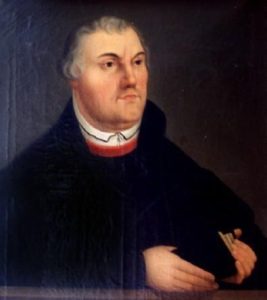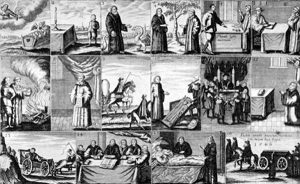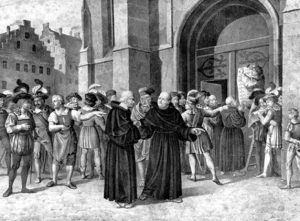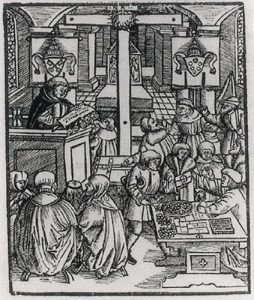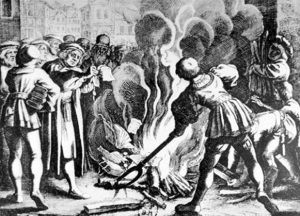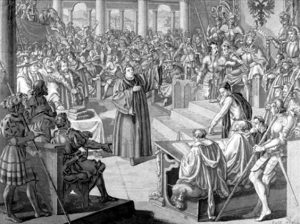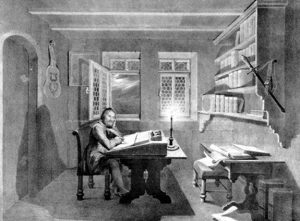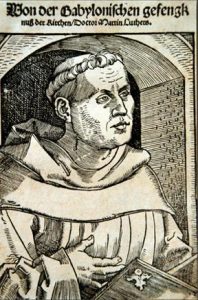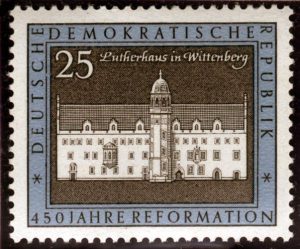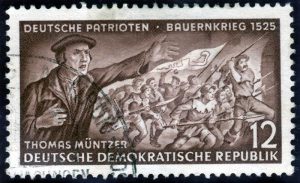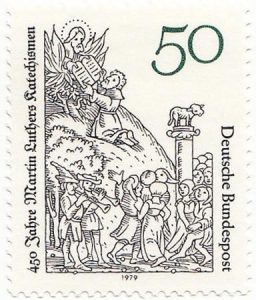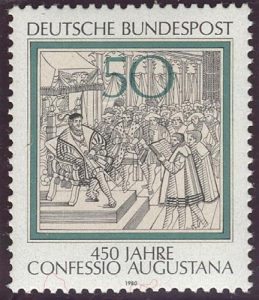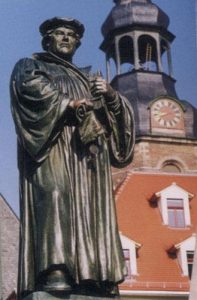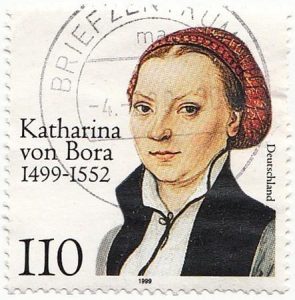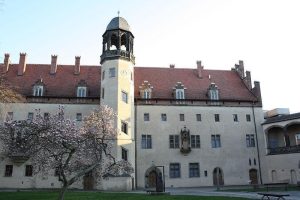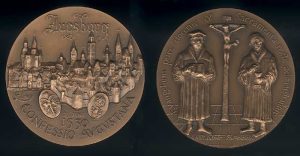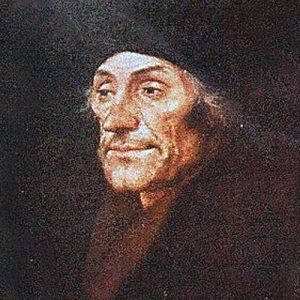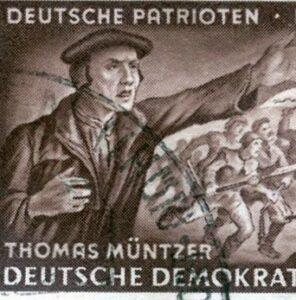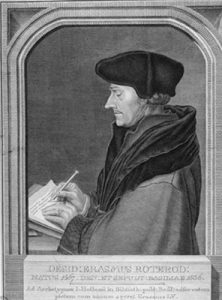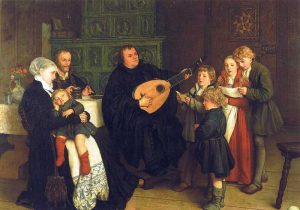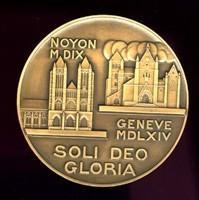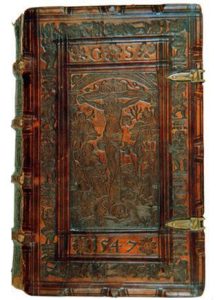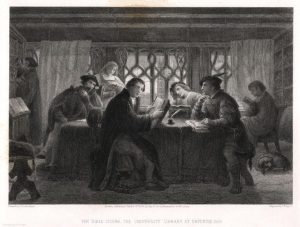The Augustin monk and the academic
Martin Luther was born in a peasants’ family on the 10th of November 1483 in Eisleben, a small town west of Halle in Saxe-Anhalt. His father, a minor in a copper mine, believed in upward social mobility for his family. Luther studied in Eisenach and went to the university in Erfurt where he started studying law. In 1505 he was caught in a storm and was terrorised by thunder that struck near him. He vowed to become a monk if he survived. A few days later, unbeknown to and against the will of his father, he joined the Augustinian monastery in Erfurt. He took his vows in 1506 and was ordained a priest in 1507. After a stay in Wittenberg where he graduated in theology, he joined the monastery in Erfurt in 1509.
In 1510 he was sent to Rome with a friar to settle a quarrel within Augustinian monasteries. He may have been shocked by the lack of meditation of the priests and the luxurious way of life of the cardinals. However, he started doubting the efficacy of prayer for souls in purgatory.
In 1512 he was a vice-prior in Wittenberg and prepared a doctorate in theology which he passed the following year. At the university he then taught theology on the Psalms, the Epistles to the Romans, to the Galatians and to the Hebrews.
In 1513 he became a professor and was appointed vicar of the Augustinians in Germany in 1515. The same year in his Lesson on the Epistle to the Romans Luther expressed his thesis on man being just and sinner at the same time.
In 1525 Luther left the Augustinians shortly before getting married.
Posting the 95 theses against indulgences
In 1515, Pope Leon X renewed the plenary indulgence his predecessor Jules II had promulgated to finance the construction of Saint Peter’s Basilica in Rome. In 1516 the Dominican Tetzel was responsible of a campaign of indulgence sales in Germany: remission of sins and temporal punishments without repentance nor confession for the living, restriction of the time spent in purgatory for the dead, for a sum of money. Such an approach was decried, notably by the prince Elector of Saxony, Frederick the Wise, who did not allow indulgences to be sold on his territory. Luther went further in his disapproval, with the 95 theses he himself nailed on the door of the church in the Castle of Wittenberg on the 31th of October 1517. Besides a violent criticism of indulgences, against which others had already spoken, Luther refused the theology of deeds: a sinner was not forgiven because of his deeds. Tormented by God’s justice who punished the sinner, Luther realised that man was justified (made just) by faith which is God given. Such was the revelation Luther described in The Tower Experience, of which no one knows the date (between 1512 and 1519) or the place where it was written.
The breach with Rome
Luther’s theses were attacked by Jan Eck, the vice-chancellor of Ingolstadt University. Pope Leon X put the general of the Augustinians in charge of bringing Luther back to his senses. Luther was ordered to appear in Rome, but Frederick the Wise asked and obtained to have him judged in Germany. The Pope appointed Cajetan, a Dominican, to hear Luther at the Diet in Augsburg. After the session, held in October 1518, Luther wrote an appeal From The Ill-informed to the Better-informed Pope and left the city secretly, but the Pope answered with the bull Cum Postquam disproving Luther’s ideas, and asking Frederick the Wise to turn Luther in. The prince Elector forbade Luther to leave Germany. The death of Emperor Maximilian in January 1519 added weight to his decision. In fact the imperial office being elective, the future emperor Charles V needed to be supported by the Elector of Saxony to prevail over the other candidate François I.
But the controversy started again. During a confrontation in Leipzig with Jan Eck, Luther claimed that the Bible was the only authority. To answer his treatise On the Papacy in Rome the bull Exsurge domine of the 15th of June 1520 ordered Luther to recant. The latter threw the bull in a fire.
The diet in Worms
As Luther’s ideas started spreading in and outside Germany, the bull Decet romanum pontificem of the 3rd of January 1521 excommunicated Luther and his supporters. Despite pressing demands of the nuncio, Charles V refused to give Luther over to Rome, but called him to the diet in Worms with a safe-conduct. In April 1521 in front of the diet, Luther refused to disavow his writings: “I cannot nor want to disavow anything because it is neither safe nor salutary to act against one’s conscience.” Charles V was furious but let Luther go. One month later, however, he was banished from the empire. Frederick the Wise, who rather liked Luther, had him abducted and sheltered in Wartburg castle near Eisenach, where Luther spent about one year from May 1521 till March 1522. There Luther was very active, writing a lot on religious life, on married life and above all working on his translation of the New Testament into German.
Towards the protestant Church
Luther was worried about the deep modifications of the mass Carlstatdt wanted. He was a radical reformer who, a little before Luther, had posted theses and lead the Reform movement while Luther was held in Wartburg Castle. Despite the cautious instructions of Frederick the Wise, Luther returned to Wittemberg and started to preach dressed as a monk.
As he did not want to upset consciences, he gradually inserted changes in the mass. First he kept Latin for the service and wore the liturgical clothes, then he inserted German, especially for the sermon. But Luther wanted to take out of the Eucharist its sacrificial aspect. Worshippers took part by singing.
In 1523 Luther’s On Temporal Authority and the Limits to the Obedience it Deserves developed the theory of the two Kingdoms, which stated that the temporal power and the spiritual power were complementary – one meant for pious men and the other to subdue the wicked. This discrepancy that discarded theocracy suited the German princes who were attracted to the Reformation.
Luther’s message was also welcomed in the free cities.
Appeal to the nobility and the revolt of the German aristocrats
Luther’s Appeal to the Nobility of the German Nation, published in 1520, dealt with the temporal powers and the Church. It aroused hopes in some nobles who wished to be freed from the emperor, the princes or the free cities. They thought Luther was an ally. In 1522 the German nobles rebelled and invaded the estate of the bishop in Trier, but Luther who did not want to forcefully establish the Reformation, did not back the rebellion.
The Peasants' war
In 1524 the peasants rebelled in Southern Germany and demanded that taxes, serfdom and the sovereignty of the Scriptures be reduced. They were forced into rebelling by Thomas Müntzer, a former monk who was in favour of a radical reform. Confronted by the peasants’ war, Luther called for peace in his Exhortation to Peace Concerning the Twelve Articles of the Schwab Peasantry, and denounced the deceitful prophets who deluded the people, thus he condemned the bloody rebellion in central and southern Germany. He described it as the devil’s work even though he was accused of having started it with his ideas. The rebelling peasants were beaten, the repression was terrible and Müntzer was beheaded.
The first diet in Spire
In 1525 François I was vanquished and imprisoned in Pavie. He was freed in 1526 and established with England, Florence, Venice, Milan, and Pope Clement VII the Cognac League against Spain, which weakened Charles V. The latter had to agree to concessions in his empire: his brother Ferdinand, who represented him at the 1526 diet in Spire, accepted the adjournment of Luther’s ban from the empire, while the princes obtained religious freedom in their states.
Thus the new protestant Church could be set up.
The organisation of the Church
In the territories of princes and in the cities who had adopted Lutheran ideas, parishes who no longer depended on bishops had to be visited, to ensure the good morals of the pastors as well as the orthodoxy of their doctrine, but also to ensure the believers’ financial contribution. In 1524 John-Frederick of Saxony, Thuringia’s regent, wanted to appoint his own visitors. Luther first refused, but then accepted that the prince or the city magistrate appoint a commission of ecclesiastical inspectors. It was composed of theologians and lawyers who assessed the life of communities belonging to the new protestant Church.
Visits to parishes revealed the need to formulate a doctrine and clarify the faith. Luther then wrote two pedagogical works: the German Catechism or Large Catechism and the Small Catechism to be Used by Poorly Educated Pastors. It was also the time of a controversy between Luther and Erasmus, who had taken a stand against the Reformation in his treatise On Free Will in 1525.
The second diet in Spire
Charles V, after the plundering of Rome by his mutinous troops in 1527, and confronted by peace prospects with France, summoned a second diet in Spire in April 1529 with a majority of Catholics. He wanted to revert to the edict of Worms banning Luther. The minority in favour of the Reformation “protested” by assuring it would not consent to any act or decision against God, the Holy Scriptures, the salvation of souls and to clear conscience. Hence the name “protestant”.
The Marburg symposium
In the empire, five princes and fourteen free cities, such as Strasburg, adopted the Reformation. Vienna was besieged by the Turks and Suleiman the Magnificent in 1529. Luther, like John the Constant, prince Elector of Saxony, was very much attached to the empire. He did not want a Protestant political union but the need for doctrinal unity seemed useful to him: that was the reason for the Marburg symposium in October 1529. The outcome was a common declaration, but diverging opinions on the Eucharist remained. Luther remained faithful to the real presence, not only symbolic, of Christ in the bread and the wine of the Last supper. He was opposed in this to other reformers, such as Ulrich Zwingli.
The Augsburg Confession
During the summer of 1530, Charles V called for a diet in Augsburg to encourage a conciliation between Catholics and Protestants within the empire. Luther was represented by Melanchthon (1497-1560) who was in favour of a confession of faith based on Luther’s ideas, and known as the Augsburg Confession; it confirmed the universal character of the Lutheran faith. The emperor did not accept the Confession and asked the Protestants to revert to Catholicism. Luther then asked Melanchthon to compose an apology of the Augsburg Confession. Charles V was furious and reinstated the Edict of Worms against Luther, and commanded the Protestants to submit before the 15th of April 1531. The electors of Hesse and Saxony refused and set up the Schmalkalden League. The emperor accepted the Nuremberg truce in July 1532.
The doctrinal unity of the Reformation in the empire was mentioned again in 1536 during the Wittenberg symposium in which Luther, Melanchthon, Bucer and Capiton took part: the Wittenberg Agreement admitted that the body and the blood of Christ were actually present in the bread and wine of the communion. Zwingli’s reformed trend was not represented.
In 1537 Luther wrote his doctrinal theses, called the Schmalkalden Articles, to prepare the position of the Reformation concerning a future council that would take place in Trente only eight years later, in 1545.
The man
On the 13th of June 1525 Luther married Catherine Bora, a former nun, who bore him six children.
During the last years of his life he attacked the Turks, the Papists and the Jews.
During his turbulent, perilous life, with times of confidence and anguish and even depression, Luther progressively became conscious of his mission. At first he was a protester condemned for heresy, then he took sides with the princes in the Peasants’ war and founded the principles organising the renewed Church.
A brilliant academic, theologian, preacher and writer, he was gifted in expressing himself in simple language, in Latin or in German. He left a great number of written works, more than 600 titles, all devoted to his religious message.
As a musician he composed a series of 36 hymns in German to be sung by the assembly of worshippers, which contributed to developing German music. The most famous of the hymns was A Mighty Fortress our God is still (Ein feste Burg ist unser Gott)
He died on the 18th of February 1546 in Eisleben, his home-town, while his Protestant Reformation was launched with a deepened spiritual renewal.

